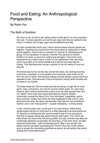Food and Eating: An Anthropological Perspective
– By Robin Fox
Conspicuous Digestion: Eating on Ceremony
The conspicuous consumption of food has always been important as an indicator of status, from three thousand pigs at a New Guinea feast to mountains of caviar and truffles at little Max Spielberg’s fourth birthday party. Lavish food entertainment is part of the ancient tradition of food hospitality used mainly to impress strangers. This can vary from the inevitable putting on of the kettle to make tea in British and Irish homes, through the bringing of bread and salt in Russia, to the gargantuan hospitality of the Near East where if the guest does not finish the enormous dish of sheep’s eyes in aspic the host is mortally affronted. We are not only what we eat, but how well we eat. Next to showing off military hardware, showing off food is the best way to impress the "outsider." The twenty-one-gun salute - fired with blanks - reminds the visitor that we can, but will not, hurt him; the twenty-one-course meal serves to show him our good will and to impress him with our prosperity. Here again, the manner of serving becomes important. Whether entertaining the in-laws at home or royalty at the palace, formality and lavishness are the key. Mrs. Beeton’s recipes astonish us today ("take thirty-two eggs and five pounds of butter…"), but she was in charge of entertaining at Ascot, and impressing royalty and business moguls was the name of the game. (Her magnificent Household Management is not only the definitive English cookbook, but what it says - a detailed and fascinating directive for young wives on everything from how to manage a large household staff to how to judge, hire, and address a second footman or upstairs chambermaid - indispensable reading for all social historians or "Upstairs Downstairs" buffs.)
The French anthropologist Claude Levi-Strauss, like all his countrymen attuned to the niceties of food customs, notes how we reserve "rich" food for the grandest occasions. The ordinary daily menu is not served, he says, and cites saumon mayonnaise, turbot sauce mousseline, aspics de foie gras, together with fine wines. "These are some of the delicacies which one would not buy and consume alone without a vague feeling of guilt," he maintains. And this "rich food" has nothing much to do with "the mere satisfaction of physiological needs." It is food meant to be shared, and to be shared with those we wish to impress. To feed someone is one of the most direct and intimate ways to convey something of ourselves to the impressee. We are never just saying, "see how we can satisfy your hunger." We are saying more like "see how lavish and hospitable and knowledgeable we are." Of the most basic things in our behavioral repertoire, eating is the most accessible and effective for conveying our messages to others. We can, of course, offer sex and violence, and sometimes we do, but food, along with superior accommodations, is on the whole easier and safer.


